
The New York City March for Science on April 22, 2017. (Credit: Max Pixel)
Last month, on Earth Day, thousands of people took to the streets of San Diego to march in support of science, joining marchers in hundreds of cities and towns across the world. Oceanographers, hydrologists, and water researchers of all kinds joined in the march.
Take a look at the San Diego Union-Tribune’s video and story from the San Diego March for Science.
Marchers brought attention to issues such as climate change, environmental protection, and vaccination. Some of the signs included:
- “Science not Silence”
- “There is no Planet B”
- “Remember Polio? I don’t”
- “Clean Water. Healthy Lives. Smart Choice.”
The march was a reminder to us that our world is undergoing rapid transformation. These changes require human adaptation, which must be informed by sound science. The foundation of good science is robust, reliable data, and that’s what we at PME are dedicated to.
Ocean acidification is a risk multiplier
For Earth Day, no assessment of our planet would be complete without a roundup of the state of our oceans. Unfortunately, the news lately has not been good. One subject we’ve been hearing a lot about is ocean acidification.
Ocean acidification is caused by increased CO2 levels in seawater, much of which has come from increased atmospheric CO2, which mixes in with ocean water at the surface. The oceans have absorbed between one-fourth and one-third of human carbon dioxide emissions.
The good news is that the oceans are absorbing CO2 at a slower rate, at least in the near term. Increased temperatures and CO2 levels mean the oceans are more resistant to taking up CO2.
And even though human-caused acidification isn’t the only risk factor for heightened localized CO2 levels, it is an enhancer for other risk factors. On the U.S. west coast and the Pacific Northwest in particular, CO2 spikes threaten the multimillion-dollar shellfish industry.
Acidification put oyster industry on the brink
Over the past several years, the oyster industry has bounced back from the brink, but ocean acidification almost derailed Washington state’s $270-million oyster industry in the 2000s.
Natural ocean currents and upwellings brought spikes in lower-pH water into Pacific Northwest oyster nurseries, where microscopic oyster larvae, known as “oyster seed,” are reared. The seed is sent to oyster farms to be “planted” and grow into adult oysters.
The acidity of the incoming water meant that the baby oysters could not extract calcium carbonate from water as effectively to form their shells.
Oyster seed production was devastated, dropping as much as 80 percent between 2005 and 2009, as this video from PBS Newshour explains.
Science helps oyster producers adapt to CO2
Producers have managed to adapt, for now. The CO2 of the seawater is now closely monitored, and hatcheries add sodium carbonate and eelgrass to manage pH. Thanks to these science-informed adaptations, growers have recovered nearly 75 percent of their losses.
Other regions, perhaps less vulnerable to environmental changes, are also being investigated for shellfish aquaculture. Recently, the Port of San Diego has used PME miniDOT Loggers to test San Diego Bay for the feasibility of oyster hatcheries there.
Great Barrier Reef coral at “terminal stage”
Across the Pacific, the world’s largest living organism, the Great Barrier Reef, is also under threat. Coral bleaching – a stress indicator – is driven both by warmer waters and acidification. Much like shellfish, coral form their skeletons by absorbing calcium carbonate from seawater.
In April, scientists in Australia completed aerial surveys of the Great Barrier Reef and concluded that back-to-back bleaching events in 2016 and 2017 have affected two-thirds of the 1,400-mile-long reef.
This means massive coral death could be imminent. The fastest-growing corals take 10 years to recover from such events. Marine researcher Jon Brodie said the reef is now at a “terminal stage.”
Scientists are now considering the possibility of cloud seeding techniques to cool the reefs in vulnerable months, a “plausible” solution according to a University of Sydney researcher.
PME’s C-Sense Logger for measuring carbon dioxide
Whether it’s the economic impacts on the Pacific Northwest oyster industry or the tourism industry on the Great Barrier Reef, ocean acidification is affecting us now.
The C-Sense Logger is PME’s device for measuring dissolved carbon dioxide concentration. Our C-Sense Logger uses a CO2 sensor developed by our partner, Turner Designs, and is rated for a maximum depth of 600 meters. Like our other data loggers, it is portable and fully submersible.